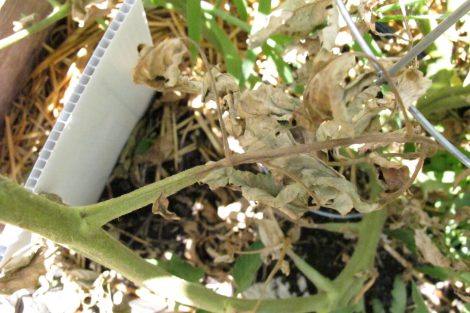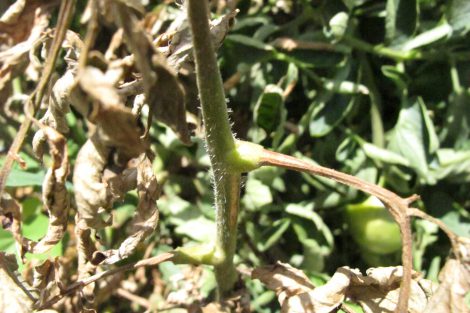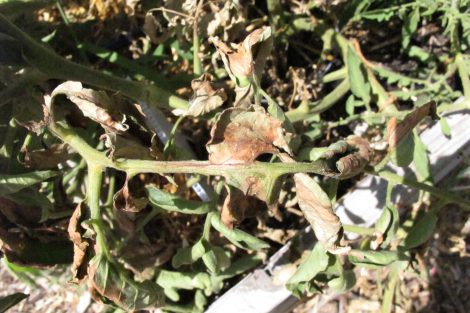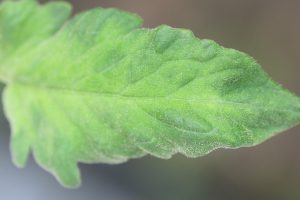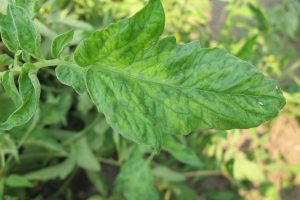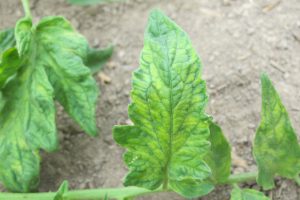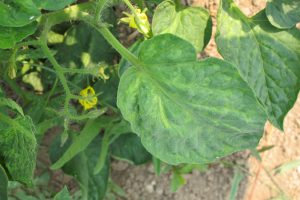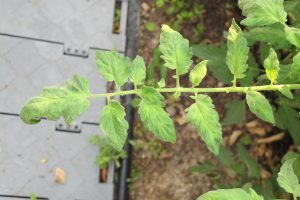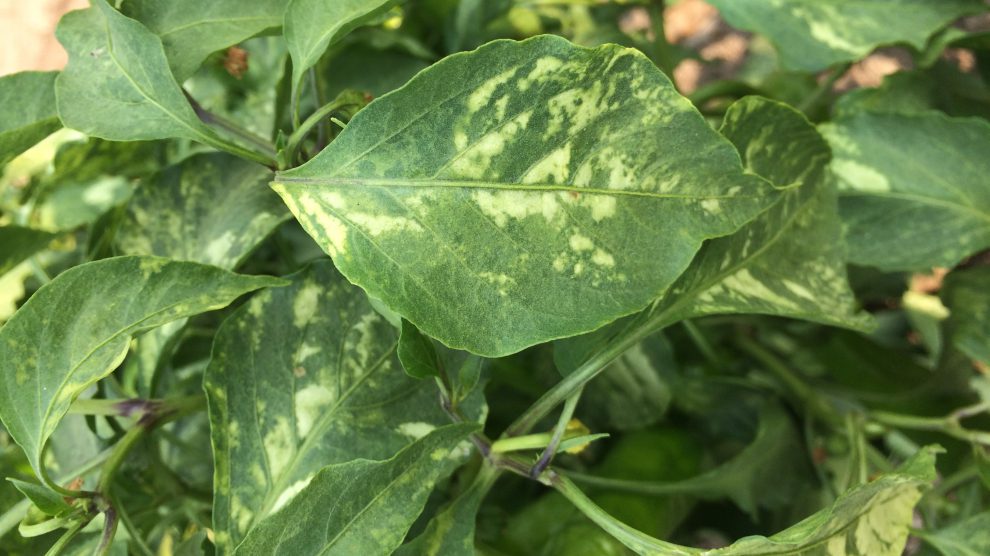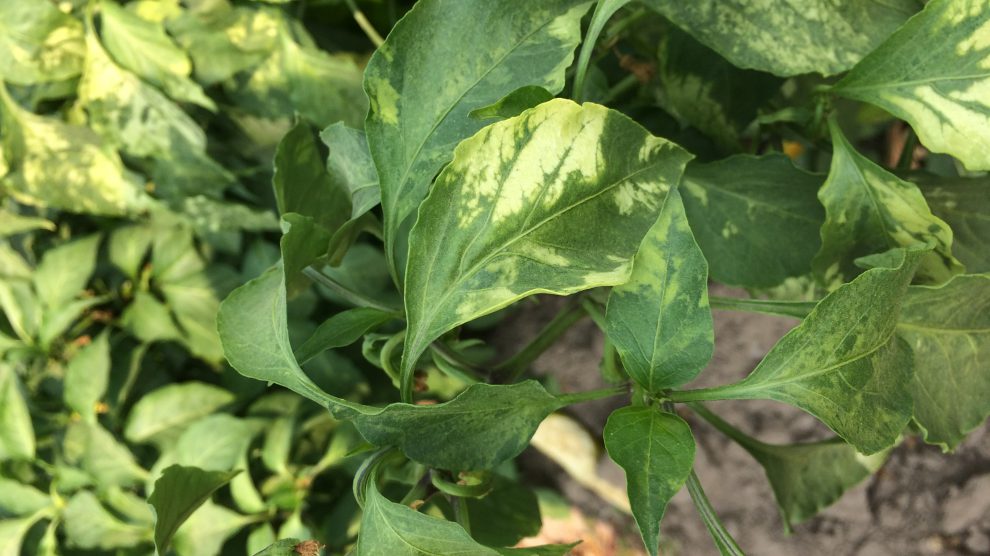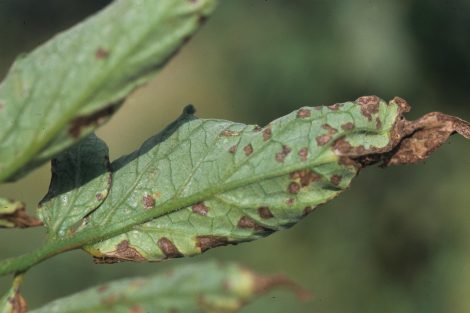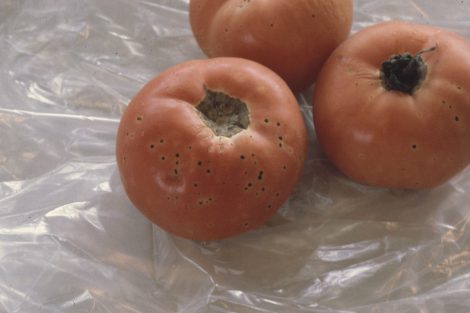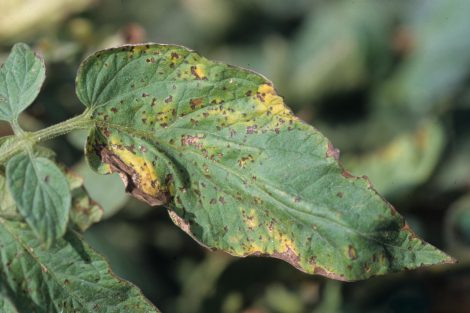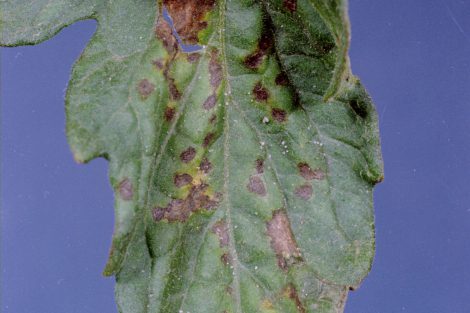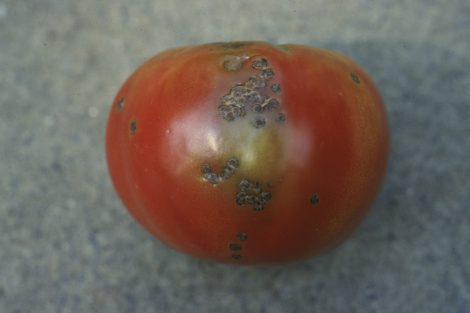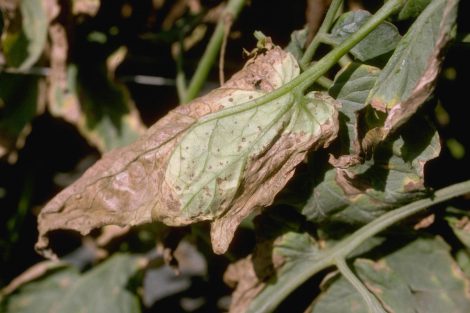In this Issue:
- Post-Harvest Cleanup / Sanitation: it’s almost time to put your fields and gardens to bed and consider cleanup options
- Tomato Russet Mites: abundant tomato russet mites this season
- Tobacco Mosaic Virus and Tomato Mosaic Virus: this persistent virus has been seen in tomatoes this season
- Alfalfa Mosaic Virus: observed in pepper plants
- Bacterial Spot or Speck: found on tomato plants
- Tomato Big Bud Virus: a rare and interesting virus seen on tomatoes this summer
- Fusarium Wilt: tomato wilt caused by a soilborne fungus
Post-Harvest Cleanup / Sanitation
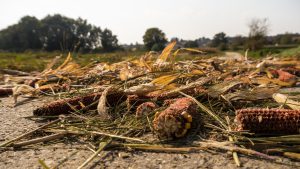
As the end of the season approaches appropriate field sanitation practices can help contribute to an overall IPM program. Sanitation is an example of a cultural control in integrated pest management (IPM). It involves removing provisions important to a pest’s survival, such as food, water, or shelter. In crop production, sanitation includes:
- Removing weeds that harbor pest insects or rodents.
- Eliminating weeds before they produce seed.
- Keeping field borders or surrounding areas free of pests and pest breeding sites.
- Destroying diseased plant material or crop residues.
These sanitation practices are all important to consider throughout the season and as the season comes to a close. Be aware that some sanitation practices may have other adverse effects. For example, crop residue can be removed from the field by plowing, shredding, chopping, burning, or feeding it to livestock. This helps remove or kill insect pests that are inhabiting the residue. However, this technique can compromise soil conservation as crop residue is a source of soil nutrients and erosion control. Crop type, pest threat levels, soil health, and field/garden history should all go into consideration when deciding how to sanitize a field after harvest and at the end of the season.
For other September gardening tips, see the USU’s Gardener Almanac and click on September.
For more information see:
- Sanitation is critical to prevent plant diseases Part 1: Greenhouse Sanitation
- Sanitation is critical to prevent plant diseases Part 2: Field Sanitation
Tomato Russet Mites
Tomato russet mites are a common issue of tomato plants and have been seen often this summer. They are most abundant during hot, dry weather in the mid- and late summer. They attack a variety of vegetables including tomato, eggplant, pepper, potato, and other solanaceous plants.
The presence of tomato russet mites often goes unnoticed due to their microscopic size until feeding injury is evident. Injury from mite feeding can cause bronzing or “russeting” of the surface of stems, leaves, and fruits. Damaged leaves may turn yellow, curl, wither, and fall from plants. Mite feeding on fruits can cause longitudinal cracks and bronze coloration.
MANAGEMENT
Cultural
- Use clean transplants. Inspect transplants carefully to be sure they are free of russet mites.
- Avoid planting during hot dry periods. Stressed seedlings are more vulnerable to attack by the mites.
- Avoid transplanting seedlings near infested crops or weeds.
- Promptly remove or destroy infested plant debris.
- Sanitize equipment. Make sure any tools or equipment used on infested plants are properly cleaned before being used on healthy plants.
- If infestations occur in the same field in successive years, be sure to remove alternate hosts such as nightshades and morning glory.
Chemical
Once russet mites are present on plants, insecticide treatment is the primary control option. Apply the insecticide to the undersides of leaves where most mites are located.
Biological
There are several predatory mites that feed on tomato russet mites; however, there is often a lag time between increase in populations of tomato russet and predatory mites.
For more information see:
Tobacco Mosaic Virus (TMV) & Tomato Mosaic Virus (ToMV)
A Tobamovirus (Tobacco mosaic virus or Tomato mosaic virus) has been detected this summer on tomato plants.
Tobacco mosaic virus (TMV) and Tomato mosaic virus (ToMV) are two very closely related viruses with similar symptoms. Antibody-based molecular testing is necessary for accurate identification. TMV and ToMV are two of only a few plant viruses that are not transmitted by insects. In contrast to many other plant viruses, TMV and ToMV can survive for up to 50 years in plant debris and for weeks to months on trellises or wooden stakes.
ToMV most commonly infects tomato, but can also infect pepper, potato, apple, pear, cherry, and numerous weeds (e.g. pigweed, lamb’s quarters). Symptoms may differ on different hosts. TMV has a wide host range of crops, ornamentals, and weeds including cucumber, lettuce, beet, pepper, tomato, petunia, jimson weed, and horsenettle.
In tomato, foliage displays mosaic symptoms that can range from a faint light and dark green pattern to a darker yellow and green pattern. Mosaic symptoms depend on plant cultivar and temperature. Symptoms are fainter at high temperatures. Other foliar symptoms include leaf distortion (fan shape) and occasionally leaf curling. In some cases, fruit symptoms will not occur. In other cases, yellow rings or brown sunken lesions will show on ripe fruit. Because fruit symptoms can be mistaken for Tomato spotted wilt virus (TSWV) infection, the virus should be identified by a plant diagnostic lab. Samples can be submitted to the Utah Plant Pest Diagnostic lab (UPPDL) for identification at http://utahpests.usu.edu/uppdl/.
MANAGEMENT
Tobacco and tomato mosaic viruses are difficult to control, as they can survive harsh conditions for many years. Once a plant is infected, there is no cure.
- Remove infected plants immediately. Do not compost infected plants due to the longevity of the virus.
- Use certified disease-free seed. When preserving seed from your own plants, do not keep seed from infected plants.
- Disinfect tools that came into contact with infected plant material. Reports from Florida indicate that dipping contaminated tools for one minute in a 20% powdered milk solution will kill the virus.
- Use new potting soil, pots, and string every time, when growing your own transplants, to minimize infection.
- Use resistant varieties.
- TMV resistant eggplant varieties including ‘Epic’, ‘Dusky’ and ‘Imperial’.
- TMV or ToMV resistant pepper varieties include ‘Telestar’, ‘Crusader’ and ‘Paladin’.
- There are many TMV and ToMV resistant tomato varieties. Most heirloom varieties are susceptible to both viruses. The correct identification of the virus is necessary if resistant varieties are to be used. Some varieties are only resistant to one of the two viruses. Break-down in resistance of some tomato varieties to the viruses has occurred.
For more information see:
- Utah Vegetable Guide: Tobacco Mosaic Virus, Tomato Mosaic Virus
- University of Minnesota: Tomato Mosaic Virus, Tobacco Mosaic Virus
- Cornell Tobacco Mosaic Virus Tomato Mosaic Virus
- UC Davis Tomato Mosaic Virus Identification
- UC Davis Tobacco Mosaic Tobamoviruses
Alfalfa Mosaic Virus
Alfalfa mosaic virus (AMV) has been found on pepper plants this summer. AMV is spread by aphids and symptoms typically occur as distinct yellow or whitish mosaic patterns on infected leaves. Infected fruit may taste bitter and be stunted and misshapen compared to healthy plants. AMV has a wide host range including several weeds and crop plants, particularly plants in the solanaceous (nightshade) and leguminaceous (pea) plant families. AMV rarely causes serious economic loss because the number of plants infected is usually low. However, it can severely infect individual plants resulting in little or no fruit production and may be more economically important in fields near alfalfa.
Management
The best way to control AMV is to avoid planting susceptible crops near alfalfa fields. Insecticides aimed at controlling aphid vectors will most likely not kill aphids before they transmit the virus to plants, and thus is largely ineffective.
For more information see:
- UC Davis Alfalfa Mosaic Virus: Pepper
- New Mexico State Alfalfa Mosaic Virus
- UC Davis Alfalfa Mosaic Virus: Tomato
Bacterial speck & Bacterial spot
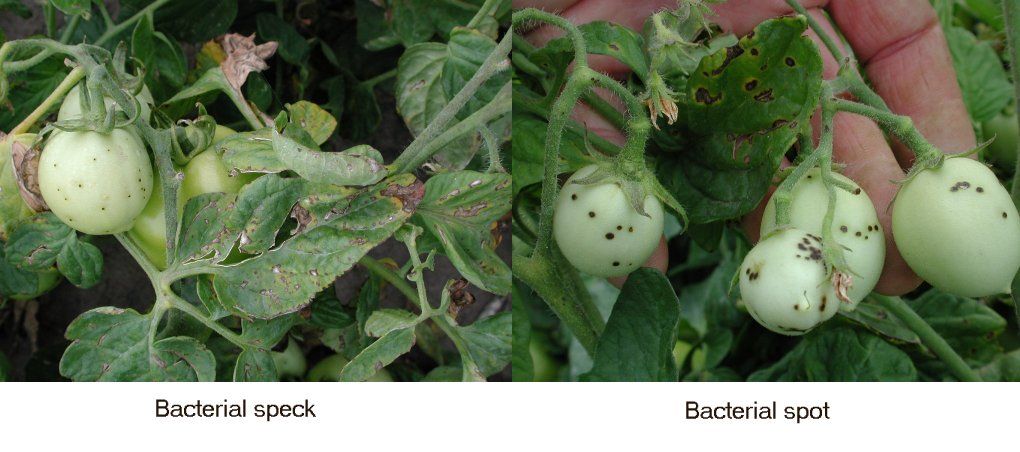
Bacterial spot and bacterial speck are two different diseases (infecting tomato and pepper) that are often confused with each other because they look very similar. One of the two diseases was found on tomato this season.
Bacterial speck is caused by Pseudomonas syringae and is spread by splashing rain or sprinkler irrigation. The bacteria survive in soil, debris, and seeds. Symptoms of Bacterial speck may also be confused with Early blight as well as Bacterial spot. Bacterial spot is caused by Xanthomonas spp. and is spread primarily through seed or on transplants and secondarily in fields by splashing rain or sprinkler irrigation. The bacteria survive in crop debris, volunteer plants, and weed hosts. Symptoms of Bacterial spot are often confused with Bacterial speck and Bacterial canker.
SYMPTOMS
Infections on seedlings (rare for bacterial speck):
- Originate from seed
- Small, greasy water-soaked spots (1/8 inch) on leaflets
Infections on plants:
- Greasy water-soaked spots on leafs
- Brownish black leaf spots initially surrounded by yellow halos
- Spots increase in size to form large irregular dead spots
- Spots may also appear on stems
- Severe infections may cause the plant to lose its leaves
Infections on fruit:
Bacterial speck
- Black sunken stippling appears early on green fruit
- Spots are small (<1/16 inch) and look like “pin-points” or “specks” on the fruit
- Spots are superficial and can be easily scraped off the fruit surface with a fingernail
Bacterial spot
- Small, greasy water-soaked spots on green fruit that become slightly raised and enlarged (1/4 inch)
- Older spots are irregular in shape, light brown to black, slightly sunken and have a scabby surface texture
MANAGEMENT
- Use disease-free transplants
- Use clean equipment and tools
- Avoid overhead irrigation
- Copper spray in early planting
- Crop rotation
For more information see:
- UC Davis Bacterial Speck Tomato
- UC Davis Bacterial Spot Tomato
- Ohio State Bacterial Speck Tomato
- Ohio State Bacterial Spot Tomato
- University of Minnesota Bacterial Spot of Tomato and Pepper
Tomato Big Bud Virus
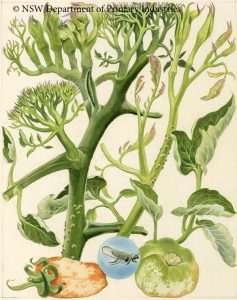
Tomato big bud virus has been seen this season on tomatoes. Big-bud symptoms are prominent with large, swollen green buds that fail to develop normally and do not set fruit. Infected leaves are yellow-green and distorted and apical stems become thick and take on an upright growth habit. Infected plants develop shortened internodes and small leaves, giving an overall bushy appearance. Tomato Big bud is transmitted by the beet leafhopper, but is generally uncommon. The disease has a wide host range, including many vegetables and weeds.
Management
Usually, only a few plants of a crop are infected and show symptoms. Management will rarely be needed. If damage is severe, it may be best to replant to avoid low yields.
For more information see: UC Davis Tomato Big Bud
Fusarium wilt on tomato
There can be several reasons for tomato plant wilt, including very hot weather, lack of water, nearby walnut trees, and root-knot nematodes. Diseases and other conditions can also cause wilt of tomato plants. This summer, Fusarium wilt was detected in tomato plants. Fusarium wilt is a soilborne fungus with initial symptoms including wilting of infected plants during the hot part of the day with recovery in the evening. Eventually, the wilt is permanent. A discoloration of the vascular tissue can be seen by cutting through the main stem.
Fusarium infection occurs through the roots and is favored by high soil temperatures (90°F) and high soil moisture. When the plants are dead, Fusarium oxysporum (the fungus that causes fusarium wilt) produces salmon colored spores, called conidia, on the plant surface that are washed into the soil by rain and irrigation water. Fusarium also produces resting spores, called chlamydospores that can survive for several years in soil and plant debris.
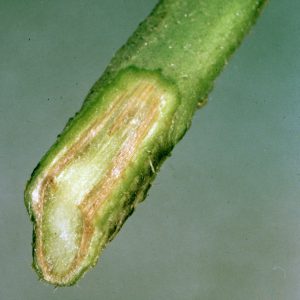
Management
Management is very difficult due to the production of long-term survival structures in the soil. There is no cure for Fusarium wilt. Plants must be removed and destroyed.
- Use resistant varieties when available. Resistant tomato varieties are available for Fusarium oxysporum races 1, 2 and 3.
- Plant on raised beds for better water drainage.
- Rotate tomato plants to another part of the garden or grow plants in containers (keeping infected soil out).
- Pull up and discard infected plants immediately.
- Sterilize plant growing equipment and supplies with a 10% chlorine bleach solution and use sterile soil-less growing media.
For more information see:

